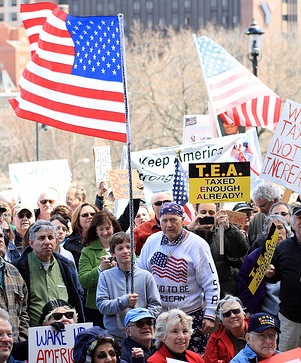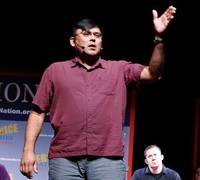 The Tea Party began as a fractious, anti-government grassroots movement, as reviled by pundits on the left as it was revered by certain commentators on the right.
The Tea Party began as a fractious, anti-government grassroots movement, as reviled by pundits on the left as it was revered by certain commentators on the right.
But in this polarizing time, it appears the Tea Party, once considered to have little ideological coherence, is gaining enough force and focus to have a considerable effect on the polls come this November.
“The GOP is waking up and realizing it’s time to take them seriously,” said UO political science professor Joe Lowndes. “The Tea Party will definitely transform GOP messaging and tactics in a lot of states. Whether it helps Republicans win seats is another question.”
Whatever the impact, it will vary from state to state, from city to city, Lowndes added, as a reflection of the varied influence and character of the movement around the country.
Lowndes’s research has focused on American conservatism, and the Tea Party represents a new and unanticipated wrinkle. “The right has never taken to the streets before. This is historically novel,” Lowndes said.
And that’s not all that doesn’t necessarily align with the historical narrative. “While they’re harkening back to this mythical idea of what the original Boston Tea Party was about,” Lowndes explained, “they’re still somewhat inconsistent in their rhetoric.”
Sandra Morgen, UO anthropology professor, and two graduate students, Jen Erickson and Patrick Hayden, have attended meetings and rallies since the Tea Party grabbed national headlines in 2009 when the media descended in droves upon its Tax Day events.
The researchers had already been collaborating on an ethnographic project focusing on tax activism in Oregon, and the Tea Party demonstrations were a boon to data collection but also a bit of a shock.
“We were used to going to any place where there was public discourse about taxes, but at the Tea Party rallies the anger was particularly intense, and the anti-tax messages were infused with rage against President Obama,” Morgen said.
Since then, Morgen has been analyzing Tea Party blogs and websites in the context of the longer history of tax activism in Oregon. She says the Tea Party movement may be a new political player, but its message draws on older conservative ideas about taxes and government, as well as racially and class-coded messages about who does and should benefit from public spending. “Hardworking” taxpayers are juxtaposed with “undeserving” recipients of government programs.
“The other side is then portrayed as comprised of greedy public employees, tax-and-spend liberals and welfare recipients who are leeching away the money,” she said. “Somewhere they lost the notion that taxes help pay for common public goods like schools and public safety.”
The ethos of the Tea Partiers can vary according to geography, and Morgen said she did sense a distinct Oregon identity.
“The strong libertarian core to the movement builds on the existing anti-tax landscape in Oregon,” she said. “In Oregon, they have entered a political terrain well sown by organizations with deep pockets, funded by large corporations and some very wealthy conservative ideologues.”
While the Tea Party has been criticized for lacking an identifiable ideology and sometimes displaying a loose grip on the facts while defending some of its positions, it appears the movement is starting to get its act together, said Lowndes.
When he attended the Tax Day rally last April, he noticed much of the racial rhetoric had dissipated and the focus centered clearly around an anti-tax, anti-regulation leitmotif. Recent surveys have also painted a clearer picture of the people involved with the Tea Party, he said: Mostly white, well-educated, middle- to upper-class citizens who are frustrated with the bailouts and government in general.
“This is not a working-class response, but a response by people who’re feeling the loss of their privilege. And they’re responding with a zealous attachment to individuality,” he said. But it’s a response, he said, somewhat at odds with America’s fundamental symbolism.
“It’s a bit paradoxical. They’re embracing this political belief in liberty expressed through radical individualism,” he said. “And yet they’re draping themselves in the flags and the founding symbols that bind us together collectively.”
— Marc Dadigan
Flickr photo by Sage Ross CC BY-SA/2.0




 Learn how experts across disciplines are together advancing green chemistry.
Learn how experts across disciplines are together advancing green chemistry.